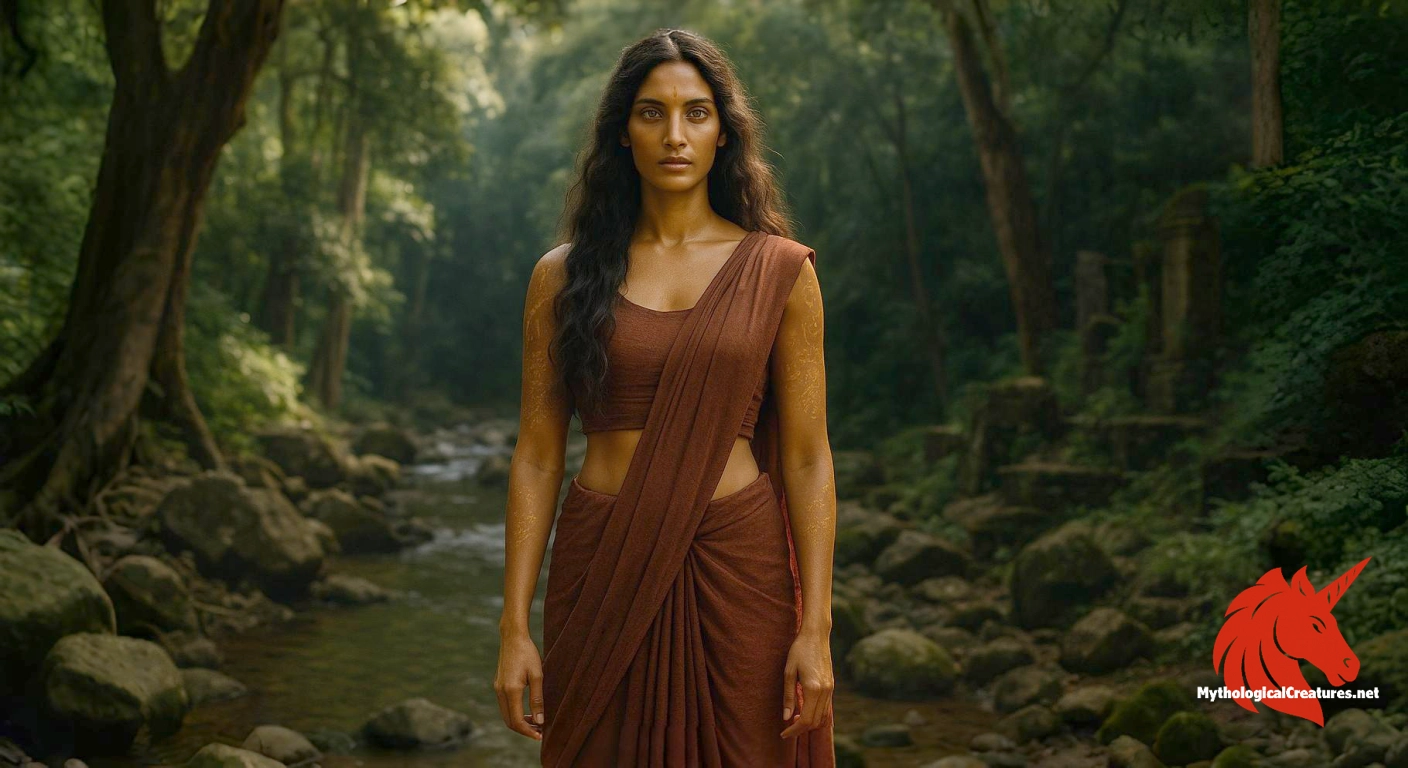Diti: Diti is a prominent figure in Hindu mythology, known as the daughter of Prajapati Daksha and the wife of sage Kashyapa.

Diti
Diti - Diti's narrative underscores the dual aspects of creation in Hindu cosmology, influencing the dynamics between divine and demonic forces.
Origins & First Encounters
Diti emerges as a fascinating figure from ancient Hindu mythology, deeply embedded in the fabric of cosmic narratives. Born as the daughter of the revered Prajapati Daksha, her origin signifies an essential link to the primordial forces of creation. She is celebrated not only as the wife of the sage Kashyapa but also as the formidable mother whose lineage spans both divine and demonic realms. Her progeny includes the Daityas, a class of powerful, often turbulent beings, as well as the esteemed Marutas, whose presence is woven into the narratives of celestial phenomena. This duality places her at the crossroads of conflict and creation, echoing the eternal struggle between order and chaos. Over the course of history, her tale has been interpreted through various cultural lenses that underscore her significance as a catalyst in the cosmic order. The multifaceted dimensions of her story invite a reflection on themes such as fate, balance, and the ambiguous nature of power. As a result, Diti stands not only as a mythological progenitor but also as a symbol of transformation, bridging the realms of light and shadow in a narrative that continues to captivate and challenge its audience.
Source Texts & Tale Variants
Ancient scriptures and Puranic texts serve as the primary wellspring for Diti’s extensive mythological narrative. Diverse accounts found in texts like the Mahabharata and various regional Puranas paint a multi-layered portrait of her life and legacy. In these narratives, she is depicted with remarkable complexity, embodying both maternal tenderness and the stern consequences of cosmic balance. The oral traditions, passed down through generations, offer variants that sometimes emphasise her tragic dimensions alongside her powerful maternal role. Numerous stories highlight the intricate relationship she shared with her husband, the sage Kashyapa, lending depth to her character and the lineage she established. Some versions cast her as a figure overwhelmed by the fateful outcomes of her choices, while others celebrate her as a necessary force in the cosmic interplay of good and evil. The array of sources reflects a rich tapestry of interpretations that echo the cultural and religious diversity of early India. Through continuous reinterpretation over centuries, these texts have ensured that her story remains fluid and open to new insights. This multiplicity of story variants continues to offer fertile ground for both scholarly debate and devotional reflection.
Form & Powers
Although the ancient texts offer limited direct physical descriptions of Diti, later artistic renditions have imbued her with an aura of enigmatic beauty and authority. Some depictions capture her with long, flowing hair and eyes that seem to shimmer with the mysteries of the cosmos, symbolising her deep connection to both the creative and destructive forces. She is often portrayed wearing garments that merge traditional aesthetics with celestial motifs, suggesting her role in the eternal cycle of creation. Artistic interpretations tend to highlight a balance in her features—a beauty marked by an underlying melancholy that hints at the burdens of her destiny. In certain portrayals, subtle elements such as faint lunar or stellar patterns are interwoven with her attire, reinforcing her otherworldly presence. Her face is sometimes rendered with a dignified calm that belies the turbulent history of her offspring, reflecting both compassion and command. Despite the scarcity of detailed iconography in early texts, subsequent cultural expressions have strived to capture her dual nature with refined symbolism. Through these varied descriptions, Diti is envisioned not only as a nurturing mother but also as a powerful embodiment of the uncertain divide between light and darkness.
Regional Faces
Regional interpretations of Diti vary widely, mirroring the dynamic cultural landscapes of the Indian subcontinent. In northern traditions, she is frequently remembered as a cautionary emblem of maternal influence, underscoring how decisions made at the genesis of life can reverberate through cosmic history. Conversely, in the south, her narrative is interlaced with local folklore that highlights themes of transformation and the inevitable cycles inherent in nature. Community-level retellings often capture the emotive dimensions of her story, portraying her as both a pioneering creator and a tragic figure caught in the web of destiny. Local temples and art forms occasionally celebrate her as an integral part of sacred rituals, thereby framing her within the broader spectrum of divine heritage. Villages and regional literatures have added nuanced layers to her legend, sometimes reflecting the dual nature of her offspring as both destructive and necessary. The regional adaptations tend to contextualise her struggles with universal themes of duality, fate, and the interplay of hope and despair. Ultimately, while the core essence of Diti remains consistent, these local variations enrich her myth, ensuring that her legacy resonates uniquely across diverse cultural settings.
Cultural Parallels
Diti’s narrative occupies a unique niche when juxtaposed with other mythological figures from a global perspective, illuminating the universal themes of creation, duality, and cosmic balance. Her role as the progenitor of both demonic and divine forces invites comparisons with other maternal archetypes found in myth, where the act of creation is inextricably linked to the emergence of conflict. In Hindu mythology, she forms a compelling counterpart to her sister Aditi, who is celebrated as the mother of the celestial deities, thus framing a dualistic vision of the cosmos. This dichotomy echoes similar patterns in global mythologies, for instance, parallels can be drawn with primordial figures in Greco-Roman traditions who also generate both order and chaos. The notion of a matriarch whose offspring encapsulate the full spectrum of life’s paradoxes also resonates with earth mother figures in various indigenous cultures. By comparing these myths, one can observe how the character of Diti embodies the broader human struggle to reconcile seemingly opposing forces. Her portrayal as both a nurturer and a harbinger of tumult underscores the universal experience of confronting ambiguity and the complexities of destiny. Such comparative analysis reveals that across cultures, myth-makers have long been fascinated by the potent symbolism of a feminine force that produces both luminescence and shadow. In this light, Diti’s story serves as a bridge connecting diverse mythological traditions under the shared motif of duality.
Legacy & Modern Evolution
The evolution of Diti’s myth reflects a broader transformation in the way ancient narratives are reinterpreted to align with changing cultural values over time. Early references in Vedic texts and the Puranas laid a foundational narrative that later generations elaborated upon with increasing layers of symbolism and moral nuance. In medieval art and literature, her image expanded from a mere ancestral figure to one embodying the complexities of cosmic balance, often serving as a metaphor for the coexistence of creation and destruction. Over the centuries, her story has found fresh expression in various cultural media, ranging from classical dance dramas and temple sculptures to modern literary treatises that explore the dichotomy inherent in her legacy. Contemporary interpretations tend to emphasise the dualistic aspects of her character, resonating with modern audiences that appreciate narratives reflecting the ambiguous interplay of light and darkness. In academic circles, re-examinations of her myth have spurred discussions about the roles of female progenitors and the responsibilities associated with creation. The persistent reimagining of her character in both scholarly research and popular culture demonstrates the timeless appeal of her myth. As modern Indian society navigates the interplay of tradition and modernity, Diti’s enduring legacy continues to inspire reflections on the forces that shape destiny. Thus, she remains a potent symbol of transformation and the inescapable tension between order and chaos.
Interesting Fact
Diti exemplifies the paradox of creation in Hindu mythology, credited with birthing both demonic and divine forces, thereby encapsulating the eternal struggle between order and chaos.
Quick Creature Info
Features:
Our Mythic Legendary Rating:

Habitat:
Supernatural Powers:
Physical Attributes:
Abilities:
Behavior:
Lore:
References
Discover Another Mythical Legend You May Not Have Heard Of?
Uncover the mysteries of ancient folklore and expand your knowledge of legendary beings from cultures around the world.
Dare to Meet the Bakwas....
Curated by the Mythological Creatures Team (rev. May 2025)
